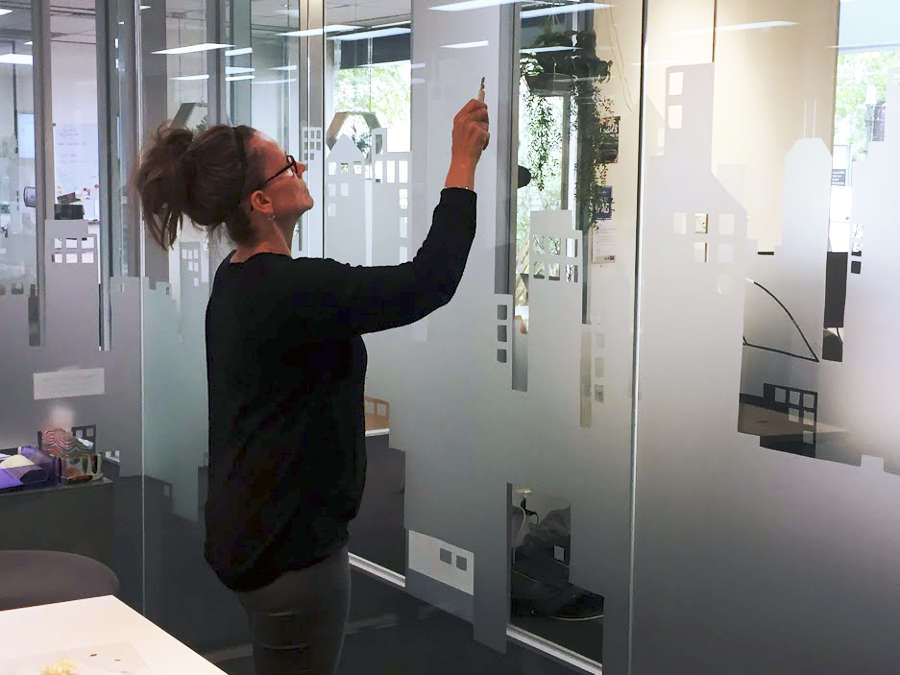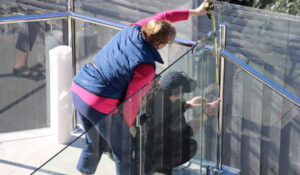Frosted window film is a popular alternative to traditional window treatments such as curtains or blinds. It is a thin layer of vinyl that can be applied to windows, providing privacy and reducing the amount of sunlight that enters a room. In this blog post, we will provide a step-by-step guide on how to apply frosted window film to your windows, as well as discussing the advantages of using this type of window treatment.
Explanation of Frosted Window Film:
Frosted window film is a translucent vinyl film that can be applied to windows to create a frosted or etched glass effect. It is available in a range of patterns and designs, and can be custom cut to fit any window size or shape. Frosted window film is a great alternative to traditional window treatments as it provides privacy while still allowing natural light to enter a room.
Advantages of using Frosted Window Film:
There are several advantages to using frosted window film as a window treatment:
- Privacy: Frosted window film provides a level of privacy that traditional window treatments such as curtains or blinds may not. It allows natural light to enter a room while preventing people from seeing inside.
- Aesthetics: Frosted window film can add a decorative touch to a room, as it is available in a range of patterns and designs. It can also provide a modern and sleek look to windows.
- Energy Efficiency: Frosted window film can help to reduce energy costs by preventing heat loss through windows. It can also reduce the amount of sunlight that enters a room, which can help to keep it cool during hot weather.
- Easy to Apply: Frosted window film is easy to apply and can be done without the need for professional help. It can also be removed easily, making it a great temporary solution for renters or those who like to change their window treatments frequently.
In conclusion, frosted window film is a great alternative to traditional window treatments, providing privacy, aesthetics, energy efficiency and ease of application. In the following sections, we will provide a step-by-step guide on how to apply frosted window film to your windows.
Materials Needed
Before you begin the application process, it is important to gather all the materials you will need to apply frosted window film.
Here is a list of the materials required for the application process:
- Frosted Window Film: This is the main material you will need for the application process. You can purchase frosted window film in rolls or sheets, and it is important to choose a film that is the right size for your windows.
- Spray Bottle: A spray bottle is used to apply a solution to the window surface before applying the film. You can either purchase a spray bottle or use one you already have at home.
- Squeegee: A squeegee is used to smooth out the film and remove any air bubbles. It is recommended to use a plastic squeegee, as a metal one can damage the film.
- Utility Knife or Razor Blade: A utility knife or razor blade is used to trim the excess film after it has been applied to the window.
- Tape Measure: A tape measure is used to measure the size of your windows, as well as the size of the film needed for each window.
- Cleaning Solution: A cleaning solution is used to clean the window surface before applying the film. You can either purchase a cleaning solution or make one at home using a mixture of water and vinegar.
- Lint-free Cloth: A lint-free cloth is used to dry and clean the window surface after it has been cleaned with the cleaning solution.
Description of Each Material and Its Function:
- Frosted Window Film: Frosted window film is the main material used to create a frosted or etched glass effect on windows. It provides privacy and reduces the amount of sunlight that enters a room.
- Spray Bottle: A spray bottle is used to apply a solution to the window surface before applying the film. The solution helps to remove any dirt or debris on the window surface, allowing the film to adhere properly.
- Squeegee: A squeegee is used to smooth out the film and remove any air bubbles. It is important to use a plastic squeegee to avoid damaging the film.
- Utility Knife or Razor Blade: A utility knife or razor blade is used to trim the excess film after it has been applied to the window. It is important to use a sharp blade to avoid damaging the film.
- Tape Measure: A tape measure is used to measure the size of your windows, as well as the size of the film needed for each window. This helps to ensure that the film is the correct size for each window.
- Cleaning Solution: A cleaning solution is used to clean the window surface before applying the film. It helps to remove any dirt or debris on the window surface, allowing the film to adhere properly.
- Lint-free Cloth: A lint-free cloth is used to dry and clean the window surface after it has been cleaned with the cleaning solution. It helps to ensure that the window surface is clean and dry before applying the film.
In conclusion, these are the materials required for applying frosted window film, and each material plays an important role in the application process. It s important to gather all the materials before beginning the application process to ensure a smooth and successful installation.
Preparation
Before applying frosted window film, it is important to prepare the window surface properly to ensure a successful application. Here are some steps to follow when preparing the window surface for application:
- Clean the Window Surface: The first step is to clean the window surface thoroughly. Use a cleaning solution and a lint-free cloth to wipe down the entire window surface. This will remove any dirt or debris on the window surface, allowing the film to adhere properly.
- Measure the Window: Use a tape measure to measure the size of the window. Make sure to measure the width and height of the window accurately, as this will determine the size of the film needed.
- Cut the Film: Use scissors or a utility knife to cut the frosted window film to the size of the window. Make sure to leave a little bit of extra film on each side of the window, as this will make it easier to trim the excess film later.
- Spray the Window with Solution: Fill a spray bottle with a solution of water and a few drops of dish soap. Spray the window surface with the solution. This will make it easier to apply the film and prevent air bubbles from forming.
Tips for a Successful Application:
Here are some tips to follow for a successful application of frosted window film:
- Start with a clean window surface: Make sure the window surface is clean and dry before applying the film. Any dirt or debris on the surface can prevent the film from adhering properly.
- Use a spray bottle to apply the solution: A spray bottle makes it easier to apply the solution evenly on the window surface. This will prevent air bubbles from forming and make it easier to apply the film.
- Apply the film to the top of the window first: Start by applying the film to the top of the window and work your way down. This will prevent air bubbles from forming at the bottom of the window.
- Smooth out any air bubbles: Use a squeegee to smooth out any air bubbles that may form during the application process. Start from the center of the film and work your way outwards.
- Trim the excess film: Use a utility knife or razor blade to trim the excess film around the edges of the window. Make sure to use a sharp blade to avoid damaging the film.
In conclusion, preparing the window surface properly and following these tips for a successful application can make the process of applying frosted window film much easier and result in a beautiful finished product.
Application Process
Now that you have prepared the window surface and gathered all the necessary materials, it’s time to apply the frosted window film. Here are step-by-step instructions for applying frosted window film:
Step 1: Spray the Window with Solution
Spray the window with the solution of water and dish soap. This will make it easier to apply the film and prevent air bubbles from forming.
Step 2: Peel the Backing Off the Film
Peel the backing off the film slowly, making sure not to crease or fold the film. You can use a piece of tape to hold the film in place while you work.
Step 3: Apply the Film to the Window
Carefully apply the film to the top of the window, making sure it is centered and level. Slowly work your way down the window, using a squeegee to smooth out any air bubbles.
Step 4: Trim the Excess Film
Use a utility knife or razor blade to trim the excess film around the edges of the window. Be sure to use a sharp blade and make precise cuts to avoid damaging the film.
Step 5: Smooth Out Any Remaining Air Bubbles
If you notice any remaining air bubbles, use the squeegee to gently smooth them out. Start from the center of the film and work your way outwards.
Common Mistakes to Avoid:
Here are some common mistakes to avoid during the application process:
- Not cleaning the window surface properly: Make sure to clean the window surface thoroughly before applying the film. Any dirt or debris on the surface can prevent the film from adhering properly.
- Not using enough solution: Be sure to use enough solution when applying the film. This will prevent air bubbles from forming and make it easier to apply the film.
- Rushing the process: Take your time when applying the film to avoid making mistakes. Rushing can cause the film to crease, fold or bubble.
- Not trimming the excess film properly: Use a sharp utility knife or razor blade to trim the excess film around the edges of the window. Be sure to make precise cuts to avoid damaging the film.
- Applying the film on a windy day: Avoid applying the film on a windy day as it can cause the film to wrinkle or bubble.
In conclusion, by following these step-by-step instructions and avoiding common mistakes, you can achieve a professional-looking finish for your frosted window film application.
Finishing Touches
Once you have applied the frosted window film, there are a few final touches to ensure that the film looks professional and seamless.
- Trimming Excess Film:
After applying the film to the window, you may have excess film that needs to be trimmed. Use a sharp utility knife or razor blade to trim the excess film along the edges of the window. Be sure to make precise cuts to avoid damaging the film.
- Smoothing Out Air Bubbles:
If there are any remaining air bubbles after applying the film, use a squeegee or credit card to smooth them out. Start from the center of the bubble and work your way outwards. This will ensure that the film is fully adhered to the window and prevent any air bubbles from forming in the future.
- Cleaning Up the Workspace:
Once you have finished applying the film, it’s important to clean up the workspace. Wipe down any surfaces that may have come into contact with the solution and use a clean cloth to dry the window. This will prevent any water or solution from leaving streaks on the window.
In conclusion, trimming the excess film, smoothing out any remaining air bubbles, and cleaning up the workspace are the final touches needed to achieve a professional-looking finish for your frosted window film application. By following these steps, you can enjoy the benefits of increased privacy, reduced glare, and a stylish new look for your windows.
Maintenance and Removal
After applying frosted window film, it’s important to properly maintain it to ensure its longevity and effectiveness. Here are some tips on how to maintain the frosted window film:
- Cleaning the Film:
To clean the frosted window film, use a soft, non-abrasive cloth and a mild, non-ammonia-based cleaning solution. Avoid using harsh chemicals, abrasive materials, or anything that could scratch or damage the film.
- Avoiding Extreme Temperatures:
Frosted window film is designed to withstand normal environmental conditions. However, prolonged exposure to extreme temperatures can cause the film to peel or bubble. It’s important to keep your windows and film protected from direct sunlight and extreme temperatures.
- Inspecting the Film:
Regularly inspect the frosted window film for any signs of damage or wear. If you notice any issues, address them immediately to prevent further damage.
Removing the Film:
If you need to remove the frosted window film in the future, here are some tips to make the process easier:
- Use Heat:
Applying heat to the film can help loosen the adhesive and make it easier to remove. You can use a hairdryer or heat gun to gently heat the film and then use a razor blade or scraper to remove it.
- Use a Solution:
Applying a solution of warm water and dish soap to the film can help loosen the adhesive and make it easier to remove. Spray the solution onto the film and let it sit for a few minutes before attempting to remove the film.
- Be Patient:
Removing frosted window film can be a time-consuming process. It’s important to be patient and take your time to avoid damaging the window or leaving adhesive residue behind.
In conclusion, maintaining frosted window film is important to ensure its longevity and effectiveness. Regularly inspecting and cleaning the film, and avoiding extreme temperatures can help keep it in good condition. If you need to remove the film in the future, using heat or a solution and being patient can make the process easier and less damaging.
Conclusion
In conclusion, applying frosted window film is a great way to add privacy, reduce glare, and enhance the overall look of your windows. Here’s a quick recap of the steps for applying frosted window film:
- Gather the necessary materials and prepare the window surface.
- Measure and cut the film to fit the window.
- Apply the solution to the window and the adhesive side of the film.
- Place the film on the window and use a squeegee to remove any air bubbles.
- Trim any excess film and clean up the workspace.
By following these steps, you can successfully apply frosted window film to your windows and achieve a professional-looking finish.
In addition, it’s important to properly maintain the frosted window film to ensure its longevity and effectiveness. Cleaning the film regularly, avoiding extreme temperatures, and inspecting the film for any signs of damage are all important steps in maintaining the film.
If you need to remove the film in the future, using heat or a solution and being patient can make the process easier and less damaging.
In conclusion, applying frosted window film is a great way to enhance the look and functionality of your windows. With a little bit of patience and attention to detail, you can achieve a professional-looking finish that will last for years to come.




